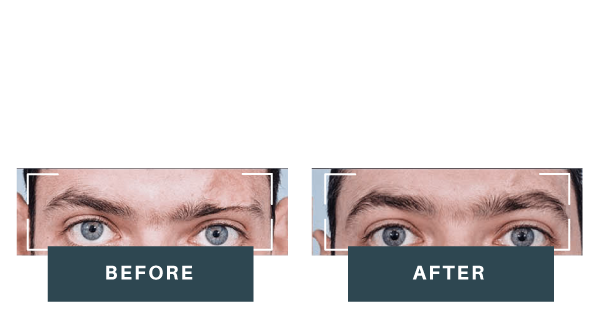Our eyebrows don’t just protect our eyes
They play a major role in the expression and image of a person.
THE DHI EYEBROW
100% NATURAL RESULTS
Hair follicles are transplanted with precision and care, ensuring natural results that look and feel great.
HIGH SURVIVAL RATE
The DHI Eyebrow transplant ensures a min. of 97% follicle survival rate, leaving you with maximised results that will last a lifetime.
NO SCALPELS, NO SCARS
The minimally invasive DHI Eyebrow Transplant requires only a short downtime after surgery – no pain, no stitches, no scars.
SAFETY & HYGIENE
Medically approved and clinically tested, the DHI Eyebrow transplant is safe and uses advanced, patented tools.
SURGEONS TRAINED AND CERTIFIED
4 Steps of a DHI Eyebrow Transplant




DHI vs FUE
DHI | FUE | |
|---|---|---|
Certified medical specialists perform the entire procedure |  |  |
Medical assistants are not permitted to perform the procedure |  |  |
Extraction process | Manual extraction of follicles by specialists using titanium-coated punches | Use of motorized extractors which generate heat and damage follicles. |
Implantation process | No slits or holes are made prior to implantation. Each follicle is inserted directly with the DHI patented implanter in a one-step motion. | Slits or holes are created in the recipient aera prior to implantation. Hair follicles are then placed in the slits using forceps in a two-step procedure. |
No scalp incisions prior to implantation |  |  |
NO Scalpels, NO stitches, NO scars |  |  |
Precise control of angle, direction and depth of implantation |  |  |
No direct handling of hair follicles |  |  |
Graft survival rate | 97% and more | 50% – 70% |
Maximum possible density |  |  |
Natural looking results |  |  |
Patients Result




Got A Question about Eyebrows?
We are an international medical group that specialises in hair loss with over 50 years of experience and scientific research.
- Our hair transplant procedures are 100% done only by medical doctors.
- Our methodology is ISO-certified.
- Only clinic in the world to provide a 97% result guarantee for all our clients.
If you are born with thin, sparse eyebrows and are looking for a permanent solution for full-looking brows, this is for you.
You may also find this procedure appealing if you’ve experienced loss of eyebrows due to genetics, age, surgeries, burns or injuries.
An eyebrow transplant can help to fill in gaps in your eyebrows or to change the shape of your brows. It can be carried out both on areas without any hair and on areas where hair growth is thin and more fullness is desired.
Whether or not you’re a suitable candidate for an eyebrow transplant depends on a few factors which can only be assessed by our DHI Hair Specialist during the consultation.
Factors that we need to consider include original eyebrows, age, availability of donor hair, eyebrow design, existing medical conditions and results of any prior or ongoing medical interventions.
In cases where you are a good fit for eyebrow transplant, the next step would be to take a blood test to rule out any other form of deficiency that may be contraindicated for the procedure.
Implanted hairs will go through a shedding phase from the 1st month up to the 4th month post-procedure. New hairs will then grow from the 4th month onwards, with 80% of the result being observed during the 9th month mark. Maximum density will be reached after 12 months.
Remember, patience is key here.
The number of follicles needed vary from patient to patient, depending on your existing eyebrows, desired design, and intended density.
You may need anything between 500 – 1,000 hairs in total and our DHI Hair Specialist will only be able to determine this after discussing with you so that we can provide you with a personalised treatment plan that matches your expectations.
In general, the number of hairs needed for an eyebrow transplant is minimal. Hence, our DHI Hair Specialist can perform a “zone shave” for you so that the small shaven donor area can be hidden and will be unnoticeable.
Before the procedure takes place, patients will receive a local anaesthetic, and you may feel a slight pricking sensation (like the tip of a pen on the scalp). Soon afterwards the anaesthetic numbs the skin, relieving any sensation throughout the procedure.
In terms of recovery, patients may experience mild discomfort, itching or redness for a few days afterwards. However, these are generally mild enough that patients are able to return to work within a day or two, at most.
Patients Reviews
I had my hair transplant done and it does not feel itchy compared to my previous hair transplant experience from another clinic. I am very thankful to the DHI team for the great treatment they gave.
The staff at DHI was very kind and helpful. They got to the root of my hair loss before recommending the right treatment for my condition. Thanks DHI!!
Amazed by the great service I've got at DHI. The team was very professional, took really good care of me, and was very kind throughout the process. Definitely recommending DHI for anyone who has hair loss issues.
Affordable and worth it. The people at DHI are so helpful. Did a transplant session was really great. Recommended!
I have recently undergone the Growth Factor treatment at DHI and want to say that I'm so happy and amazed to see the progress in just two weeks' time. Not a big change for others but I feel a sense of confidence in me now. Thanks DHI!!!
Professional and very friendly staff. Did my transplant last month, feeling happy with the amazing result. Good job!
Had a transplant at DHI recently, result was better than expected. Thanks to the DHI team for their patience in answering all my questions and suggesting the best for me.
Very impressed with the results. Excellent service. Highly recommend.
Just visited DHI for the first time, I have received a very professional and fruitful consultation.

